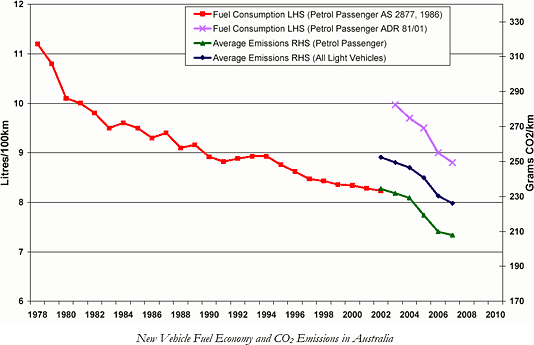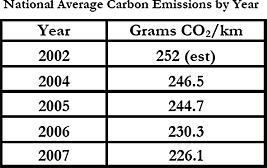Overview
National Average Carbon Emissions (NACE) for all new light vehicles sold in Australia for 2007 was 226.1 g CO2/km. This continues the decline in carbon emissions of new vehicles, placing the industry well on track to achieve its target of an average 222 g CO2/km by 2010.
Background
In March 2003, the Federal Chamber of Automotive Industries adopted a voluntary target aimed at progressively improving fuel consumption for new petrol passenger vehicles to an average of 6.8 litres per 100 kilometres (l/100 km) by 2010. The FCAI established this target to demonstrate the continuing commitment by the Australian automotive industry to improving environmental performance.
In mid 2005, to reflect the need to reduce carbon emissions, a new industry target was established for a reduction in average CO2 emissions for all new light vehicles (< 3.5 tonnes gross mass) to 222 g CO2/km by 2010. Accordingly, this target incorporates a significantly broader range of vehicles (cars, SUVs and light trucks, etc.) and all fuel types (petrol, diesel, LPG, etc.).
Over recent years there has been a continuous improvement in average new vehicle emissions from an estimated 252 g CO2/km in 2002 to 226.1 g CO2/km in 2007 (see chart). If the current rate of progress, continues the target will be achieved before 2010.
All new vehicles sold in Australia are required to report emissions in terms of grams of CO2/km. The NACE is calculated using emissions data and new vehicle sales data (VFACTS). Simply, the NACE is the average ‘grams of CO2 emitted per kilometre’ of all new light vehicles sold in Australia.

Questions & Answers
1. What contribution is the automotive industry making to efforts to reduce greenhouse gas emissions?
Passenger cars account for less than 8 per cent of Australia’s total carbon emissions which is around half of the emissions from agriculture. However, the automotive industry accepts that it has a responsibility to make a significant contribution to efforts to mitigate the effects of climate change.
Over many years, the Australian automotive industry has sought to encourage progressive reductions in the fuel consumption of new cars.
In more recent years, as awareness of the causes and effects of global climate change has grown, the industry has responded with a new and broader target to achieve significant improvements in the CO2 emissions of new vehicles over the period to 2010.
As mentioned above, the industry has adopted a target to achieve average emissions for all new light vehicles of 222 g CO2/km by 2010. This target incorporates all light vehicles up to 3.5 tonnes (cars, SUVs and light trucks, etc.) and all fuel types (petrol, diesel, LPG, etc.).
Recent progress has been strong. Over the past 5 years average CO2 emissions have been reduced by more than 10 per cent (see table, below). This reduction reflects a range of influences, including changes in market segmentation; advances in engine technology and vehicle design; and growth in alternative fuel types (particularly diesel).

2. Why do we measure CO2 rather than fuel consumption?
In 2005, the FCAI converted from a target for enhanced fuel economy to a target to reduce CO2 emissions, reflecting the importance of CO2 as a greenhouse gas. The adoption of a target for average CO2 emissions allows the industry to report on the performance of a broader range of vehicles with different fuel types, including diesel and LPG, using a comparable basis of measurement.
The Australian Government requires all new vehicles sold in Australia to be fitted with a label showing fuel consumption and CO2 emissions, measured on the basis of a standardised drive cycle. This provides a convenient basis for the comparison of emissions performance from one model type to another. Data summarising the fuel consumption and CO2 emissions performance of individual vehicle models is also reported on the Green Vehicle Guide website.
3. What is the automotive industry doing to further reduce CO2 emissions ?
Globally, automotive manufacturers are investing heavily in a range of technologies and advances in vehicle design that have the potential to make further significant contributions to reducing motor vehicle CO2 emissions. Some of the key approaches being pursued include:
- Development of advances in electric vehicle capability and design, including advanced battery technologies.
- Improvements in vehicle design, including increased thermal efficiency in engines; reduced friction loss; enhanced aerodynamics; reduced rolling resistance; and reductions in vehicle weight.
- Advances in hybrid vehicle technology.
- Development of enhanced alternative fuels capability, including ‘new generation’ renewable biofuels.
- Hydrogen fuel cell vehicles.
Significant opportunities exist for the uptake and the further development of a range of these technologies by the Australian automotive industry. The Australian automotive industry invests around $700 million a year in research and development, more than any other manufacturing sector.
4. Are there any constraints to the introduction of more fuel efficient technologies?
An important element in reducing vehicle emissions from the cars will be the availability and development of fuels that allow engines to operate at higher efficiencies and produce fewer emissions.
There is a direct relationship between the quality of fuel put into a vehicle and the level of emissions from that vehicle and therefore improvements in the quality of fuels offers opportunities for further improvements in vehicle emissions.
Improved diesel standards have recently been adopted in the Australian market however, the availability of enhanced quality petrol in Australia is a limitation on the ability of car manufacturers to introduce emerging engine technologies.
Improvements in the quality of petrol available in Australia would allow vehicle manufacturers to adopt more advanced emissions technologies. In particular, some advanced emission control technologies are sensitive to the sulphur content in petrol. Further improvements in petrol quality will need to be achieved if the Australian market is to receive the full benefit of these technologies.
The Australian automotive industry is looking to work with government and other stakeholders to develop a timetable for the introduction of enhanced fuel quality standards for Australia.